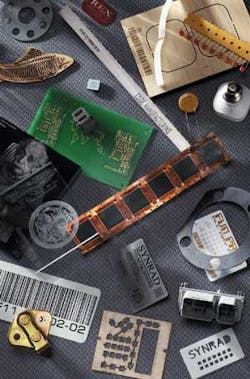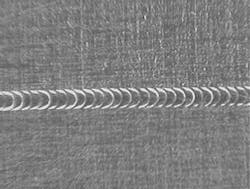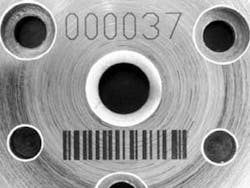Sealed CO2 lasers—tailor-made to suit today's applications
The evolution of the sealed CO2 laser since its introduction in the mid-1980s is a testament to its usefulness in a broad number of industries that now employ the technology. These lasers can be found in compact systems cutting intricate patterns in delicate cloth, drilling holes as small as 50 µm in surgical catheters, engraving 3-D designs, marking 2-D barcodes on automotive glass, cutting sheet metal and in hundreds of other applications. The low cost and minimal maintenance requirements of low-power CO2 lasers make them appealing to many manufacturers—plus, they offer users the benefits of small size, rugged construction and operating lifetimes in excess of 45,000 hours.
Improvements in sealed CO2 lasers have been largely customer-driven with a variety of resonator designs, power levels and model configurations now available from several manufacturers. New designs address challenges related to laser size, weight, constraining RF cables, external RF supplies and cooling options. Prices continue to drop, making the technology financially feasible to a greater number of applications.
Application tailored
Lasers can be designed from the start with power, mode quality and wavelength requirements that best match a given application. For example, as a result of the advances in beam quality and the shrinking of the CO2 laser, previous applications that would have required a very large CO2 laser or a more expensive shorter-wavelength laser can be solved more economically. Better beam quality and pulse shape allow high-threshold applications such as cutting 1mm-thick titanium sheet, or even welding sheets of copper nickel alloy with less than 200W. Faster rise/fall times have helped laser engravers process at more than 100 inches per second, and automotive customers can now choose an air-cooled laser model to mark serial numbers or 2-D barcodes on steel parts.
Technology choices
Today, users may opt for the excellent beam quality produced by a small gap resonator design, with its short rise and fall times, for high-speed marking and engraving applications. Or they might choose the economy and high power output (200–500W) of the "slab" or wide-area "free space" type resonator technology for applications such as cutting metal. Or the customer may select still another type of laser, which is a hybrid of the two, possessing some of the advantages of both.
null
Narrow gap waveguide resonators usually have higher gas pressures than their "free space resonator" counterparts. This results in improved pulse rise and fall characteristics and higher watt/cm2 of electrode area. Excellent beam quality is a trademark of this technology. The trade-off is that a waveguide structure can require tighter assembly tolerances and expensive highly machined surfaces. The "free space" resonator design, which yields a lower watt/cm2 of electrode area, can be a more economical design, which means lower overall cost per watt.
For example, Synrad's new firestar series of sealed CO2 lasers features three different resonator designs, each designed to provide optimal performance at the laser's target power level. These are designed and packaged cost-effectively by using economical aluminum extrusions for the laser housing, and precisely controlling the assembly of the internal resonator structure. These structures, or "sandwiches," can be optimized for any number of advantages. Laser power, pulse rise and fall times, beam polarization and critical mode quality are all parameters that can be controlled.
null
In the case of higher-power lasers (100 W+), economy is the key. Low dollars per watt are achieved by the use of a simple electrode structure, a structure with a low parts count and a minimum number of expensive high-tolerance machined surfaces. Additionally, new compact RF power supplies provide increased efficiency and lower cost. These smaller RF power supplies may be fully integrated into a laser head, completely removing the need for the use of a remote driver and cables connecting the two. This is even possible at power levels up to 200 W. These lasers can be run at CW power for three shifts per day on a shop floor, with minimal maintenance. They are well suited for cutting anything from textiles to stainless steel.
Some applications require even further optimization of the laser to suit their more stringent demands. Specialized laser models have been developed to address these applications utilizing alternate wavelengths and pulsing technology. Sealed CO2 lasers in the 9-µm range are useful for processing plastics that are more absorbent of this wavelength, such as polyimide and silicones. Kapton, for example, cuts faster, with a substantially improved edge quality at a 9.3 µm wavelength versus 10.6 µm. The number of materials that are addressed with a 9.3 µm wavelength continues to be expanded.
Q-switched CO2 lasers, with short pulsewidth, high repetition rate and high peak energy, are commonly used for via drilling of printed circuit boards and micro-machining applications requiring minimal thermal damage. Because of the high peak energy, users will generally pay a premium for this highly specialized technology.
New features
Today's laser designs are increasingly user-friendly. They are smaller, lightweight and can be air-cooled at higher powers than ever before. State-of-the-art RF technology has led to smaller RF power supplies for higher-power lasers, enabling them to be integrated into the laser head, eliminating cables from the laser head to RF supply. This is a huge benefit when the laser is mounted on robots and large-area gantry systems. The laser systems are more reliable and cheaper because excess RF does not have to be designed in to compensate for cable losses.
Getting rid of waste heat was a handicap to air-cooled designs above 50 W. With the addition of advanced ceramics to increase cooling efficiency, air-cooled models are now available in output power levels that have traditionally been the exclusive domain of water-cooled lasers. Heat can now be easily transferred to highly efficient heat sinks where it is removed by fans. Synrad's firestar t80 laser, for example, can supply more than 80 W CW from a compact air-cooled package less than 24 in. long.
Lower cost
null
New, more cost-effective technologies, combined with higher volumes have significantly reduced the cost of sealed CO2 lasers. Manufacturers are using economical materials such as aluminum for heat sinks and tube housings, inexpensive yet robust ceramics to control critical tolerances, and sharing parts across multiple product lines. Overall, OEM laser prices are down by more than 10 percent from just two years ago.
The future
These advances open up many new possibilities for the CO2 laser. Currently, about 10,000 sealed CO2 lasers are sold each year. As the cost per watt drops, and performance increases, new applications will continue to be uncovered. The CO2 laser of tomorrow will continue to evolve. It will continue to get smaller, have better performance and be easier to use. This technology has made its way into the realm of consumer goods. It has already shown up in vending machines marking wallets, in systems personalizing baseball bats, and in clothing stores marking jeans. It will undoubtedly see further growth into mainstream use as a tool for just about any application needing heating, cutting, marking, welding and so on. Clearly, the sealed CO2 laser will continue to be a viable solution for numerous applications for many years to come.
Greg Dunham ([email protected]) is senior R&D technician and lab coordinator at Synrad Inc., Mukilteo, WA.




